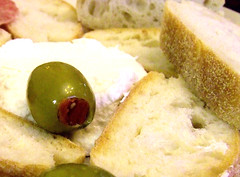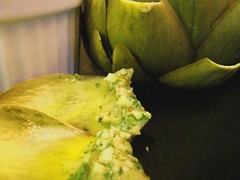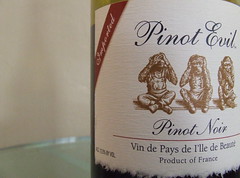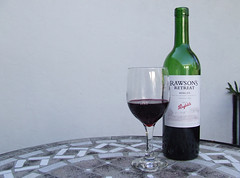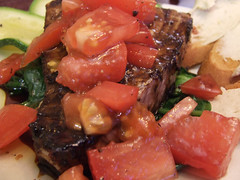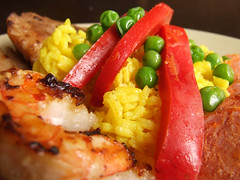This post originally appeared in Satellite Magazine
Fresh matters. You can ask any cook worth her salt and she’ll tell you the same thing. Fresh, whole ingredients impart even the simplest dishes with deep, rich flavor. However, since most grocery store produce travels an average of 1,500 miles to get from the farm to your plate, getting fresh produce can sometimes be a challenge. Lucky for all of us, Gainesville is full of farmer’s markets. The Union Street Farmer’s Market in the Sun Center is open every Wednesday, rain or shine, and features fresh, seasonal ingredients grown by local farmers.
While buying locally will give you the freshest food, it can also limit your choices. You won’t get oranges in summer and you won’t get asparagus in fall. But then, eating seasonally is a wonderful exercise in menu planning and can connect you to the local land and community.
Lucky for us, summer is here, which means many produce items such as cantaloupes, blueberries, chicory, tomatoes, swamp cabbage (water spinach) and leeks are at the height of freshness and are readily available:
With just a few other ingredients, these items can be cobbled together to make for some wonderful dishes, from refreshing fruit salads to delicious savory entrees:
Grilled cantaloupe with chicory and blueberry vinaigrette
Ingredients:
For the dressing:
- 1 4.4oz container of blueberries, mixed variety (approx. two large handfuls) – most juicy berries will work with this recipe: raspberries, blackberries, and others. Avoid cranberries as they’re probably too tart, and strawberries won’t provide enough juice
- 1 tablespoon apple cider vinegar
- 2 tablespoons water
- 1 tablespoon brown sugar (you can substitute honey, also available at the farmer’s market)
- A pinch of salt
For the salad:
- 1 large cantaloupe, seeded, cut into wedges and peeled
- 1 bunch chicory, stems removed, rough cut
Dressing:
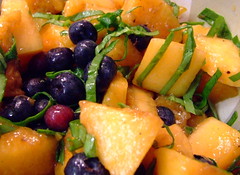 Begin by pureeing the blueberries. You can use a food processor, blender or hand blender. If pressed, you can juice them in a bowl by grinding them to a pulp with the back of a large, heavy spoon. A slow process, but infinitely gratifying.
Begin by pureeing the blueberries. You can use a food processor, blender or hand blender. If pressed, you can juice them in a bowl by grinding them to a pulp with the back of a large, heavy spoon. A slow process, but infinitely gratifying.
Once the blueberries have given up their juice, whisk in the vinegar (for brightness) and add the water. Toss in the salt, and slowly add the sugar, tasting and whisking as you go. Don’t be afraid to stick your fingers in the dressing and taste it! Some people like sweeter dressings while others like their dressings more sour or bitter. Don’t be afraid to experiment and feel free to alter the ingredients’ ratios to get it to your liking.
Salad:
This is a rustic dish, which is a fancy way of saying you don’t have to be too careful with the cutting.
Begin by heating a large skillet over medium-high heat. While the pan heats, sprinkle the cantaloupe wedges with just a bit of Kosher salt (optional) Once the pan achieves temperature—it should feel hot when you’ve got your hand about two inches above the pan—place the cantaloupe wedges in the pan, cut side down. Let them sear about 45 seconds on each side. When it’s done, set the cantaloupe aside to cool.
*The salt will draw out some of the melon’s moisture and help concentrate the sugars in the cantaloupe. Searing the cantaloupe will caramelize some of the sugars that have been brought to the surface and will give it a deeper, richer sweetness.
Once the melon has cooled, cut it into bite-sized pieces and mix it with the chicory in a large bowl. Store in the refrigerator for at least 30 minutes. When you’re ready to serve, plate the cantaloupe salad and drizzle liberally with the blueberry dressing.
Alternative: Once the cantaloupe has chilled, mix with fresh, whole berries and sprinkle with powdered sugar or drizzle with honey for a deliciously sweet, healthy dessert.
Pan seared tuna with balsamic glaze and crispy leeks
The real star of this dish is the sauce, which can be used to top any number of proteins, from tuna or chicken breast to extra firm tofu or tempeh.
Ingredients:
Sauce
- 1/2 cup balsamic vinegar
- 3 medium fresh tomatoes* @3/4 of a pound, diced
- @1 cup water spinach leaves
- 4 garlic cloves, crushed and peeled
- 1 table spoon olive oil
- 1 table spoon brown sugar
Remaining ingredients
- 2 large leeks cut to matchsticks (pieces 1/4 inch wide, 2 inches long)
- Peanut, canola or vegetable oil
- 1 tablespoon olive oil
- 4 Tuna steaks
- Salt
- Pepper
The sauce:
Begin by heating a skillet over medium heat. Add the olive oil, wait for it to heat and then add the garlic cloves. Let them cook for about five minutes, stirring occasionally. While those cook, you can whisk together the balsamic vinegar and brown sugar (the sugar will provide a sweet counterpoint to the vinegar’s acidity and will also help the sauce come together as more of a glaze). You could also add extra ingredients to enhance the sauce, such as lemon or lime juice, white wine, or sherry. After the garlic’s cooked, add the spinach and tomatoes--holding some of the diced tomatoes in reserve for a garnish. Let them cook for about five minutes, stirring occasionally, and then add the vinegar mixture. Increase the heat to medium-high and let the sauce cook until it begins to bubble. Then reduce the heat and let simmer for about 20 minutes.
When you’ve got about 10 minutes left you can start on the final pieces of your dish. For the leeks, you need to put about a half-inch of peanut oil in a sauce pan and bring it up to 350 degrees. One it reaches that temperature, drop in the leeks in small batches and let them cook until they’re golden brown (about 30 - 45 seconds, probably). Use a slotted spoon or a fork to transfer them to paper towels to drain.
For the tuna, rub the tuna steaks with garlic (one clove each) and sprinkle with salt and pepper. In a hot pan with the remaining tablespoon of olive oil, sear the tuna on each side--about two minutes. To plate, put down a bed of the fried leeks, top with the tuna steak, and then spoon on some of the sauce. Finally, top with some of the reserved tomato pieces for a dash of color.

This dish is deceptively easy and mighty impressive when plated.
While you could make any of these dishes with ingredients that have traveled half-way across the country (or farther), why would you? Fresh ingredients taste better, and you get the satisfaction of supporting your local growers and being a part of local community. Plus, everyone I spoke to at the farmer’s market was knowledgeable, friendly, and even had a cooking tip or two.
*Fresh tomatoes far outshine grocery store tomatoes in taste and versatility. If you’re not buying fresh tomatoes, you might as well be buying them canned.
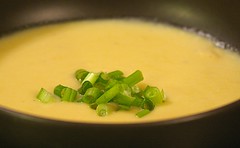
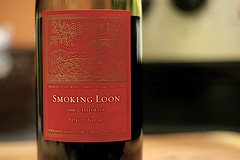 Color: A deep, translucent ruby color. Nearly watery on first appearance
Color: A deep, translucent ruby color. Nearly watery on first appearance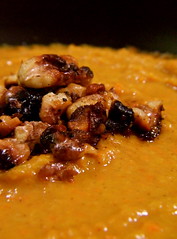
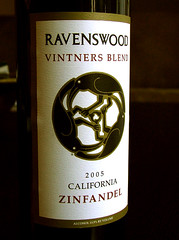
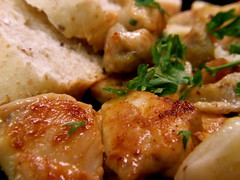
 The succulent nature of this dish and the somewhat heavy flavor of the chicken skin and garlic call for a well-structured wine with good tannins. Espelt Wineries’ 2005 Sauló (an organic wine made from garnacha and carinena varietasl) is a shining example of just such a wine.
The succulent nature of this dish and the somewhat heavy flavor of the chicken skin and garlic call for a well-structured wine with good tannins. Espelt Wineries’ 2005 Sauló (an organic wine made from garnacha and carinena varietasl) is a shining example of just such a wine.

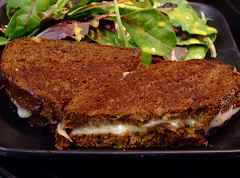
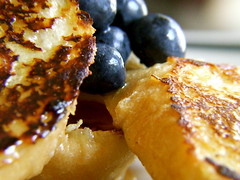



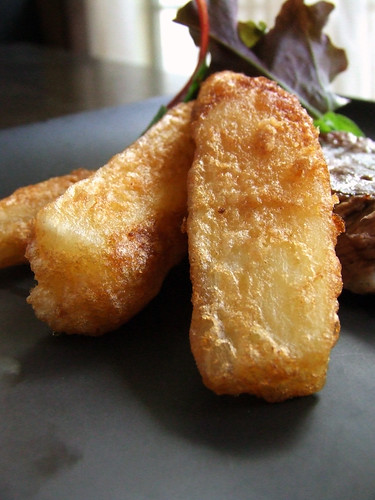

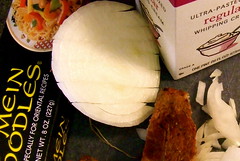





 Tempranillo is one of my favoriate varietals, and while this varietal from San Luis Opispo County in California lacked some of the minerality and subtleties normally associated with old-world wines, it was still a nice representation of the Spanish grape
Tempranillo is one of my favoriate varietals, and while this varietal from San Luis Opispo County in California lacked some of the minerality and subtleties normally associated with old-world wines, it was still a nice representation of the Spanish grape

